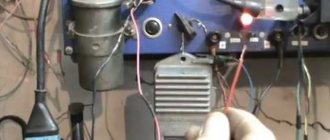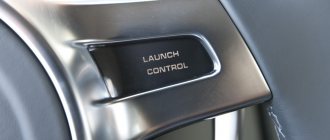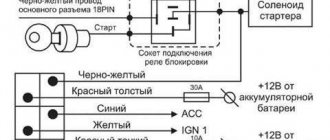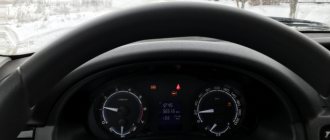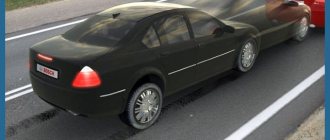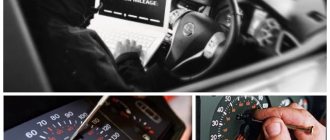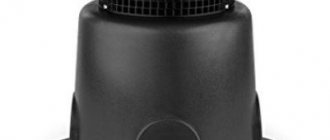Programming the device
Digimaster odometer corrector
In addition to equipment, there are also a number of programs that allow correction. The most common option is an odometer calculator, which allows you to calculate the speed depending on the wheel size, crankshaft speed and gearbox gear. For cars of the brands "Hyundai", "Ford", VAZ, "Mazda", "Toyota", "Kia", the Stool program is used to correct odometers. It is also possible to adjust the odometer using - this is an adapter (universal) necessary for working with twisting programs
Also check out the Amprog odometer programmer and the Digimaster II odometer corrector.
For those who prefer to buy complex options, the optimal solution is to purchase 5 PRO odometer programmer software. Its kit includes:
- programmer;
- adapters USB-PO5, BDM-PO5, EEPROM-PO5;
- Scheme for restoring MS-1 instrument combinations.
The choice of program and adapters depends on the brand of your vehicle, type of device, and financial capabilities.
What is a speedometer
A speedometer is a device that measures the movement of a vehicle. The meter readings are displayed in km/h (kilometers per hour) or - in America - miles per hour. There are two types of speedometers: mechanical (analog), digital. How does the speedometer work and what does it show? In a rear-wheel drive car, the speedometer controls the rotation of the secondary shaft at the gearbox, in this case the speed is calculated from it. Accordingly, the speed readings will depend on the tire size, the rear axle, and also on the device’s own error. For front-wheel drive vehicles, speed is measured using the left wheel drive. The curvature of the road adds to the speedometer error. We looked at the odometer and speedometer above (the difference is what they are used for, principles of operation). Let us now find out the reasons for speedometer errors.
Operating principle of the odometer
Twisting the odometer and methods for determining the actual mileage of a car
In scientific terms, an odometer is a mechanical or electronic device that determines the number of revolutions made by a wheel, that is, a counter. Thanks to this information, the car owner can determine the path traveled by the car during its entire service life or over a certain period of time. That is, the information received by the device is communicated to the driver in numerical form, and specifically, the kilometers traveled.
The principle of operation of the device is as follows: for one kilometer traveled by a car, the wheel makes the same number of revolutions. Knowing how many revolutions it has made in total during a particular path, it is easy to calculate the kilometers traveled, and this is what is displayed on the odometer.
In addition, by resetting the odometer data before driving, you can easily set the distance from point A to point B or calculate how much the car traveled on one fuel fill. Probably any driver knows about all these functions of the odometer.
Odometer in a car, its types, purpose and principle of operation
If you want to puzzle a car enthusiast, ask him what an odometer is or where it is located in the car. Despite the fact that people resort to his help regularly, not everyone knows what he looks like. This is an important device that is found in every vehicle powered by an internal combustion engine.
Judging by the name, you can already determine that this is a measuring device, like a tachometer or digital speedometer. The odometer measures the number of kilometers traveled.
Odometer
The device of modern odometers
Why is urea needed in cars?
In order to understand how the odometer can be adjusted, let’s understand how the odometer works. We will understand both the electronic version and the mechanical one. It’s not in vain that we remember the mechanical device; this type of device is still used on some cars, and there are still not a few cars on which it was installed even earlier.
Mechanical odometer
Mechanical odometers are a miniature counter in a plastic case; only its numbers are visible on the car’s dashboard. Typically, all mechanical-based devices have a special gearbox that converts the movement of the shaft into the rotation of numbers on the dashboard. For example, if a particular gearbox has a gear ratio of 500:1, then the shaft must rotate 500 times in order for the device to show 1 kilometer. The shaft is a flexible cable woven from a tight spring; the cable itself is located inside a special metal tube, which is also covered with a rubber braid to prevent corrosion. This structure rotates the driven shaft of the adventure gearbox, to which it is connected. Inside the odometer housing there is a complex of several worm gears. They all rotate each other in sequence.
Any mechanical odometer has special pins that stick out from one side of the mechanism. When the pin runs into the gear, the largest number turns - thousands. One of the pins hits the gear tooth and rotates along with the indicator until the others move. The pin that is connected to a certain serial number takes part in all this, thereby making 1/10 of the turn.
Electronic odometer
Here everything is a little simpler and more complicated at the same time compared to the previous version. On the one hand, all these wires and gears, pins and generally rotating wheels with numbers are missing. On the other hand, complex electronic sensors are appearing that are connected to the vehicle’s on-board computer. The electronic odometer system uses a special gear, which has found its place on the transmission shaft. Next to it there is a magnetic sensor, which records every moment the gear passes past the sensor. There is also a slightly different system that uses slotted wheels and a light sensor. Despite the installed system, the car’s electronic control unit always determines with great accuracy how far the car has traveled.
Information based on counting magnetic or light pulses serves to update the odometer readings on the dashboard. After processing the information, the computer sends a signal through wires to a device on the dashboard. Here, adjusting odometers requires a lot of effort. All information about the collected pulses is strictly stored in the memory of the control unit and cannot simply be changed.
Checking the accuracy of the odometer readings
You can check both electronic and mechanical devices. However, with electronic everything is somewhat simpler. This is especially necessary when buying a used car; very often owners try to hide the true age of the car in order to sell it more successfully. To check it, you just need to go to a service station and ask the electricians there to connect to the control unit. And everything will become known in one moment.
If the car does have a mechanical odometer installed, then you will have to do it yourself. As you know, the easiest way to unscrew the treasured numbers back is to disconnect the cable from the gearbox and rotate it in the opposite direction. This can be done using a conventional electric drill; manually it is very time-consuming and labor-intensive. You can check whether the cable has been disconnected simply by climbing under the car. If the nut or bolt securing the cable is clean, but everything around is dirty, the cable is guaranteed to be removed.
Why and how to rewind odometers
The reasons for conscious corrections of the odometer readings may be:
- desire to reduce the actual mileage of the car;
- attempts to hide improper use of the machine;
- elimination of some difficulties with documenting the official vehicle fleet;
As we can see, the reasons are mostly not very correct and decent. If you reduce the actual mileage figure, the car can be sold at a higher price. If you roll back the odometer to certain values, you can hide the fact that the car has been driven, and sometimes driven a lot, when it should be sitting quietly in the garage.
However, today equipment is officially being produced that allows you to adjust the indicators even for electronic odometers, which without special skills and knowledge is a very difficult task. Moreover, in a number of European countries, such manipulations are punishable by a prison sentence, which is quite significant for such tricks.
The easiest way, from a technical point of view, is to rewind the mechanical odometer. The cable is removed from the shaft, attached to a drill or other similar power tool, after which it rotates for some time in the desired direction. But not all even mechanical odometers allow you to rewind yourself so easily. Then you have to remove the counter itself and perform more complex manipulations with it.
As for electronic odometers, of which the majority are today, they are rewound using special devices and software that enter the changed data into the memory of the car’s on-board computer. In some cases, it is necessary to reprogram one or more on-board controllers, because the readings of the magnetic wheel speed sensors are transmitted not only to the odometer.
It should be noted that altered odometer readings not only mislead either the potential buyer or the person monitoring the use of the car, they can be an obstacle to the timely completion of the car, maintenance, or even the correct diagnosis of certain problems. Therefore, in the vast majority of cases, such corrections are essentially fraud.
Many car enthusiasts have probably come across such a word as “odometer”. What is this - an odometer? Where is it used and what is its principle of action? Let's take a closer look at these questions.
An odometer (in everyday life - a counter) is a special device that measures wheel speed and, as a result, the distance traveled. Many people confuse this device with a speedometer, but the difference between an odometer and a speedometer is significant. The speedometer is designed to determine the speed of the vehicle, while the odometer is not capable of providing such indicators. Its purpose is to determine the mileage of the vehicle (if we are talking about a car).
Typically, an odometer consists of a sensor that is connected to the axis of rotation of the wheels, and a counter with an indicator that displays the result for the observer. And in order for the observer to see the desired result, drivers often use odometer adjustments.
Types of odometers
Today, there are three types of odometers: mechanical, electronic and electromechanical. Modern cars are most often equipped with Hall sensors, which are based on the electromagnetic effects of conductors and a magnetic field.
Every driver has seen a mechanical odometer. In all outdated domestic car models, mechanical instruments are installed, which are a drum indicator showing the distance traveled.
An electronic odometer is installed on modern cars and provides for reading incoming pulses (rotations) from measuring instruments (odometer sensor) to the counting inputs and their further conversion into the necessary physical units of measurement (meters, kilometers, miles).
Electromechanical odometers consist of a mechanical wheel speed sensor and an electronic sensor that displays information on an electronic display.
Odometer error
What is an odometer? Any such device is not an ultra-precise measuring instrument, therefore they are subject to established errors in the readings. According to the observations of many motorists, the odometer error is about 5-10%. Manufacturers, relying on legislation, reduce the actual warranty period of the car, increasing the indicators by unknown amounts. That is why twisting the odometer within a few kilometers is not a serious violation or concealment of information about the car’s mileage.
How to remove the odometer before selling it?
Before selling, car owners reduce the actual mileage, thereby increasing the final cost of the vehicle. As a rule, the twisting of different types of odometers is carried out in different ways:
- An electronic odometer requires the intervention of an experienced specialist who can disassemble the sensor panel, cut the tracks and reprogram the electronic chip using a computer. To convert electronic odometers, various programs such as VDO Research, Combiset 1.6, etc. are used.
- A mechanical odometer can be twisted by any mechanic. To do this, remove the small odometer cable from the gearbox and rewind it in the opposite direction using a small electric motor or a conventional drill. After this, the cable is installed in its original place.
- Electromechanical odometers are twisted in the same way as mechanical ones. After twisting the indicators and restarting the engine, the sensor will display the values that were specified by the user.
In Germany, tampering with odometers is not considered an offense because it does not constitute legally relevant documentation. This is why odometer rolling in Germany is a profitable business. In Ukraine and Belarus, many service stations also offer similar services for the preliminary preparation of a car before sale. For $20-50, a mechanic can easily change all the indicators.
As a conclusion, we note: reducing the odometer readings is not only an unethical and incorrect attitude (and even deception) towards a potential buyer, but also an illegal action, especially if the purchase and sale agreement stipulates this point as essential.
Many of you have heard phrases from motorists “what is the mileage on the speedometer”, “wind up the speedometer”, “twist the speedometer”, “wind up the speedometer”, “adjust the speedometer”, “wind up the speedometer”, “how to wind up the speedometer”, but only a few know that the word speedometer is used erroneously in these phrases. The speedometer and odometer are two completely different measuring instruments, one of which determines the instantaneous speed of the car, and the second the mileage in km or miles. Therefore, it is correct to say not “wind up the speedometer”, but “wind up the odometer”, “adjusting the odometer readings”, and not “adjusting the speedometer”.
The speedometer was invented about a hundred years ago, at the dawn of the automobile industry. It is unknown who invented the first speedometer. It is believed that the first speed measuring device was installed on an Oldsmobile automobile produced in 1901. According to other sources, FORD MOTOR Co began installing the first speedometers on its cars in 1910. Some historians believe that the invention of the first speedometer belongs to the famous inventor, physicist, engineer Nikola Tesla, who filed a patent for invention No. 1209359 in 1916. The design of the speedometer has remained virtually unchanged for a hundred years, with the exception of some modern car models.
It is not known exactly who invented the odometer. Some scientists attribute the invention of the odometer to the ancient Greek mathematician from Syracuse - Archimedes (287-212 BC), others - to the Chinese scientist and inventor Zhang Heng, others - to the Greek mechanic and mathematician Heron of Alexandria (10-70 BC). . BC.). Mention of the first odometer can be found in chronicles of the 1st century AD. It was a cart. The size of the wheels was mathematically calculated and with a rotation of 400 times it measured exactly 1598 m. The gear transmission of the device was driven by the wheels of the cart; the distance counter was small pebbles falling into the tray of the cart. With the development of electronics, the design of speedometers and odometers has also improved. Modern dashboards operate on slightly different principles. Electrical signals - impulses from ABS sensors and speed sensors are sent via the CAN Bus to the dashboard processor, processed and reflected as readings on the odometer.
Odometers allow you to accurately determine how many revolutions a car wheel has made. Knowing the number of revolutions of the wheel, the microcircuit or processor calculates the distance traveled. Most often, odometers are electrical, mechanical or electromechanical. The odometer shows both the daily and total mileage of the vehicle in kilometers and miles. These data allow you to accurately determine how far the car has traveled over a certain period of time and over the entire period of operation. Mileage information is displayed digitally on the vehicle's dashboard.
Mechanical odometer. The design of the mechanical odometer is simple and reliable. When exposed to mechanical force, the counter counts wheel revolutions and converts them into kilometers traveled. When a certain extreme mileage number is reached, the mileage is reset to “0”. The mechanical odometer can be wound up using any twister.
Electronic-mechanical odometer. Wheel revolutions are read by a speed sensor based on the Hall effect. When the car moves, the sensor produces pulse signals at certain intervals. Over one kilometer of travel, the speed sensor transmits about 6000 signals to the electronic side of the speedometer. The data is converted into digital format and displayed on the car's dashboard. To adjust the mileage on the electronic-mechanical odometer, you will need a CAN twister.
Digital odometers are the most modern devices. All information received from the sensors is processed by the microcontroller. To correct it, special equipment is required.
Instrument panels, odometers and speedometers on modern cars operate on different principles. On some dashboards, the electrical signal arrives via the CAN bus in the form of a pulse from a speed sensor based on the Hall effect, on other panels from ABS sensors.
Modern equipment allows you to correct odometer readings on cars, trucks, motorcycles, and snowmobiles. The time and price of the adjustment depends on the model, year of manufacture, complexity of the preparatory work (removing the dashboard, disassembling the speedometer, removing the arrows), etc.
,
“You don’t need to explain anything to me, I have 100 thousand kilometers on my speedometer,” you can often hear such a phrase among those arguing about cars. But the formulation of the thought is completely incorrect. If you analyze the speedometer and odometer, the difference between the instruments is obvious. It is the odometer that shows the mileage of the car, while the speedometer determines the speed of movement.
Speedometer odometer 2ZV.ru
The clutch is slipping on VAZ 2108, 2109, 2109 cars
More details about the operation of the device: When the ignition is turned off, the indicators are off and the current consumption is negligible. If you turn on the ignition, the device turns on all indicator segments for self-diagnosis (it will be immediately visible if any segment is faulty). Then, after a couple of seconds, the device begins to display the speed and previously selected mileage. By briefly pressing the button, the display mode of daily or total mileage is switched. When the daily mileage is shown on the display, a long press (more than 2 seconds) resets the daily mileage counter to zero. After turning off the ignition, the device displays the word “RECORD” for a few seconds and all odometer values are recorded in the non-volatile eeprom memory, so even disconnecting the battery will not reset the odometer.
Each counter has its own format: General odometer ХХХХХХ (low-order digit 1 kilometer) 6 characters, without a dot. Daily odometer ХХХХ.ХХ (low-order digit 10 meters), 6 characters, 4th dot lit
This device is calibrated for a sensor that has 6 pulses per 1 meter, or equals 1 meter per 1 revolution. This formula is suitable for most cars. (For example! The speedometer is made for a Japanese car, in which 0.62 revolutions equals 1 meter (or 1 revolution 1 mile), and in order not to violate the formula there is a sensor of 10 pulses per 1 meter (0.62 revolutions = 1 meter = 6 pulses, or 1 revolution = 1 mile = 10 pulses). The device can also be calibrated to work with almost any sensor and mileage to pulse ratio
This can be done by editing the source text. Copy the source text into the “mplab ide” program, edit and compile a new corrected hex file. Here is a video of a fully assembled shield, while there is no oil pressure sensor and the device shows the maximum pressure IMPORTANT!!! It is better to install quartz, kx -3ht 10.0 mhz. This is a thermostable resonator operating temperature: from -40 to 85 °C, it is several times more expensive. On LEDs for uniform illumination of inscriptions, cut off the lenses and matte the surface in any way available to you
Why is the speedometer lying?
If you look at a car's speedometer, it's not hard to guess why it's lying. Why does it show the speed limit? Firstly, the driver has less chance of breaking the speed limit and getting a fine. Secondly, if the speedometer indicated a lower speed than the real one, then, most likely, drivers would not stop suing automakers, proving their innocence of speeding. Does the speedometer have to lie? The fact is that this device is the most difficult to provide super-accurate readings, because the speed depends on the rotation of the wheel, on its diameter, and this is a very unstable parameter.
The speedometer error at a speed of 60 km/h is very minimal, it is practically non-existent. At a speed of 110 km/h, the error may be 5-10 km/h. If a car reaches a speed of up to 200 km/h, then the average error can be up to 10%. We have answered your question “what are odometer and speedometer”. The difference is now clear. Let's summarize. All of the above makes it possible to draw the following conclusions.
Speedometer-odometer voltmeter
CONTEST
This article presents a device that is installed in the dashboard of a car and partially replaces the on-board computer.
I’ll start with some background. I once installed a dashboard from a foreign car in my car and realized that the speedometer terribly does not match the real speed indicators. It was decided to install an on-board computer. No sooner said than done. Many functions, etc., eventually failed, and I had to do it myself.
From all the functions, I realized that I really only needed a few basic ones, so that's what I did.
On the Internet, I looked at a few things separately and put it all together into a complete device presented below. From the necessary readings, I chose: an on-board voltmeter, a speedometer and an odometer (the total mileage is not resettable, and the daily mileage is resettable). Also, in mine The panel did not show the standard indicator of the fuel level in the tank, I set the voltmeter reading switch, it shows either the voltage of the on-board network or the voltage drop on the tank sensor. The readings are of course not in liters, but in some numbers, so I remembered the readings of an empty tank, a quarter, a half, 0.75 tank, and a full one. And based on the readings, I can determine the amount of fuel in the tank.
Now about the scheme.
The voltmeter is assembled on a pic16f676 microcontroller, I used transistors PNP Indicator with a common anode, with a dynamic indication of three digits. The speedometer-odometer uses a microprocessor pic16f873a, transistors operating on anodes, reverse conductivity, an indicator for the speedometer with three digits with a dynamic indication with a common anode, For the odometer I took two indicators with OA with dynamics.
Sensor description:
The operating algorithm is as follows: A voltage of 12 volts from the battery is always supplied to the circuit, but from the ignition switch pin 15/1 it is supplied both to the circuit as power and to the 21 MK pin, and when the ignition is turned off, the circuit is not immediately de-energized, but recording occurs mileage data in the EEPROM of the controller, when the recording was successful, the microcontroller gives a command to the switches, which remove the supply voltage of the entire circuit. During recording, the word “recording” lights up on the odometer indicator. The printed circuit board is equipped with a switch that either supplies power to the speedometer anodes directly or sends it through a resistor, which in turn, at night, “mutes” the brightness of the glow so as not to dazzle, but if you don’t need it, you can put a jumper on the board. (which is what I did) When you turn the ignition key, the voltmeter, speedometer and total mileage readings light up, to go to the daily mileage, you need to briefly press the reset button, and to reset the daily mileage, you need to hold the same button for a long time, and The word “reset” will appear on the indicator. The circuit works on my machine, and already on a friend’s machine. So the circuit is fully operational and tested in the field. And also, in the voltmeter, instead of a trimming resistor, I set a constant 13 kOhm (in my case) so that the readings do not get lost under the influence of vibration. And also, the photo shows a board from the first experiment, there The tracks have not been completed, but you are presented with a completely finished board, with all the changes.
Photo of the finished device
Download firmware with sources + software file.
Bicycle odometers
In a world of minute-by-minute changes and perpetual motion, you have to constantly monitor the speeds and distances traveled. As the March Hare said in Lewis Carroll's fairy tale, "You have to run as fast as you can just to stay in one place, and to get somewhere you have to run at least twice as fast." Cyclists also want to keep up with the times. That is why not only professional athletes, but also amateurs are in a hurry to purchase such a device as a bicycle odometer.
What is an odometer
A bicycle odometer is a device necessary to measure the number of wheel revolutions while riding. Modern odometers accurately determine the total mileage of a bicycle, helping the owner to correctly imagine the capabilities of his vehicle. The display of the device shows both the daily and total mileage of the bike.
How it works
Different types of odometers have different designs, but the underlying operating principle is the same. The following parts of the device can be considered functional:
- counter (responsible for counting the number of wheel revolutions);
- controller that records revolutions (it is directly connected to the counter);
- an indicator reflecting numerical indicators of kilometers traveled on the speedometer display.
In mechanical odometers, the force to the cable is transmitted from the drive wheel, which is in close contact with the bicycle tire.
In odometers with electromechanical transmission, the impulse is transferred along a cable using a sensor to the electronic panel. Electronic models operate by receiving electrical impulses.
How does it work
Regardless of how fast your vehicle is moving, its wheels make a certain number of revolutions to cover a kilometer of travel. This figure remains unchanged. Knowing the number of wheel revolutions, it is easy to calculate the number of kilometers traveled and display it on the counter. In different types of odometers, counting and transmission occur differently.
There are three types of odometers:
- mechanical;
- electromechanical;
- electronic.
Older and gradually becoming a thing of the past mechanical models operate using a special flexible cable that rotates at the same speed as the wheel. The rotation is transmitted by the output shaft, then the force goes along the cable to the magnetic needle. The magnetic needle displays a numerical value on a magnetized disk.
Quite simple in configuration, the mechanical odometer is relatively cheap. It is easy to disassemble and repair, replacing old parts with new ones. Its operation does not depend on batteries or magnetic storms. Meanwhile, with proper installation and configuration, such a device copes with its main function of elementary calculation of kilometers.
A disadvantage can be considered the automatic zeroing of readings upon reaching a certain threshold figure. In addition, the mechanical device makes it somewhat difficult to rotate the wheel, and if the wheels are curved in a figure eight, it does not work at all. Dirt entering the device may also affect the meter readings. So such an odometer must be frequently and thoroughly wiped and lubricated. But for walking on a clean and smooth highway, a device with a mechanical transmission is quite suitable.
Electromechanical odometers work by rotating a gear, which applies force to an electromechanical sensor.
The sensor device produces pulses of electricity that travel through wires to the speedometer unit, where a small electric motor rotates, acting as a drive for the odometer. Odometers of this type are installed on most modern cars.
Electronic odometer sensors are completely electronic. In addition, they have LCD indicators. Such a device is more difficult to “deceive”; this will require the use of a special device.
How to measure the diameter of a bicycle wheel
Modern bicycle odometers, in fact, become part of the “on-board” bicycle computers, which calculate not only the total mileage of the bike, but also many other movement parameters necessary for cyclists who are seriously involved in cycling training. These could be, for example, indicators such as:
- current speed;
- average speed;
- distance length;
- travel time;
- cadence;
- mileage;
- watch.
The sensor of the electronic odometer is a contact hermetically located in the housing - a reed switch. It is mounted on the front fork stays or (when the length of the wires is sufficient for this) near the rear wheel. A permanent magnet is attached to the spoke of the wheel, which causes the sensor to trigger. The time between the two nearest sensor activations is monitored by the microcontroller. Liquid crystal indicators with seven segments reflect the result obtained, the backlight function is performed by LEDs.
Are there any errors in the operation of bicycle odometers?
Like any device, the odometer may have an acceptable percentage of errors. Mechanical devices installed on mountain bikes or bikes riding on rough terrain can produce up to 15% errors. It is believed that the more severe the operating conditions of the vehicle, the higher the error. For example, slipping, weakening of the flexible cable (it must be tensioned, it should not be allowed to sag in the loops), or loose parts can negatively affect the operation of the odometer. True, such a high distortion rate is still not typical for new generation bicycle odometers. Electromechanical devices can produce up to 5% distortion. But digital gadgets, which have no mechanical connections between parts and minimize the risk of internal damage, produce no more than 1% errors.
How to choose the right device
If you have clearly decided that you need a bicycle odometer and will not become another toy hanging idly on the steering wheel, before installation, first of all, you need to choose a high-quality device that will not have to be thrown away after the first cycling season.
When choosing an odometer, you need to consider the following parameters:
- reliability of the device;
- reading limit;
- case quality;
- functional;
- fastening type.
The most reliable bicycle meters are produced by companies such as VDO, BBB, Cateye, Sigma. You can choose a model individually, based on the goals you set for yourself.
Odometers are divided into models with a maximum speed of 99.9 km/h and devices that display three-digit indicators. For example, the Sigma 506 speedometer shows speeds above 100 km/h. This device is designed for cyclists. Amateurs are unlikely to find it useful.
Devices may vary in size and compactness, but functionality does not depend on this. You can even purchase a device in the form of a wrist watch that measures an athlete’s pulse.
You can also mount the cycling computer on the handlebar stem or the handlebar itself. There are devices with universal mounting.
The ideal odometer model should have a large display with clearly readable numbers.
The device must be able to withstand vibration and harsh weather conditions, and its components must be of good build quality.
How to set up an electronic odometer
To begin installing a bicycle computer is, first of all, to correctly specify the parameters of your vehicle. It is best to do this immediately after purchasing the bike. It is best to record and save the indicators.
- First you need to set the indicator C - the length of the wheel. It needs to be clarified, since this number is non-standard. To do this, measure the perimeter of the tire using a measuring tape wound around the wheel in a circle. Another way: put a bright mark on the wheel with paint and, after rolling the bike one revolution of the wheel, measure the distance from one mark to another.
- Then you need to use electrical wiring to mount the sensor on one of the fork legs or on the bike frame.
- Next, we tightly wrap the wire around the feather and the brake cable.
- We install a mounting platform on the stem or steering wheel.
- We fix the magnet on the spoke, but do not overtighten the screw so as not to break the magnet. There should be no more than 3 mm between the magnet and the sensor.
- We fix the bicycle computer in the contact pad and check the quality of work.
A bicycle odometer is a necessary device in the life of every modern cyclist. With skillful use of the device, you can timely predict maintenance periods, correctly distribute sports loads, and comfortably move long distances during a bicycle trip. A well-chosen and reinforced odometer makes life on two wheels easier and increases your chances of staying on track.
velofans.ru
Difference between speedometer and odometer
What is the difference between the two instruments: speedometer and odometer.
People who have never driven a car, as well as just beginning drivers, may well ask this question, which is clear for an experienced driver.
However, despite the apparent simplicity of the answer, we will go deeper into the story and reveal some nuances that you may not know.
Speedometers did not appear on cars right away. At first, when the word “car” was something new, and most self-propelled chariots were still equipped with steam engines, a speedometer was simply not needed. And there is a very logical explanation for this.
At this time, the cars did not pick up speed that could directly threaten human life. It is difficult to imagine a fatal traffic accident occurring at a speed of 15 kilometers per hour. But cars were no longer being developed at that time.
With the development of technology and the increase in the maximum speed of cars, acceleration control was required, because the human, so-called eye, could no longer cope.
Subsequently, at the dawn of the 20th century, a device was invented that made it possible to measure the speed of a car. This is how the first speedometer appeared.
The principle of its operation was extremely simple, and the speed was measured using simple mechanical devices and a cable connecting the shafts with an indicator arrow.
It is interesting that speedometers working on this principle existed for almost a century, until the 2000s all over the world, and in the automotive industry of our vast homeland they were used until 2013 on VAZ cars.
The odometer appeared a little later, when the need arose to measure distances. The device itself operates from the same mechanisms that power the speedometer, but it performs a completely different function than its older brother.
The odometer counts the kilometers or miles traveled by the vehicle based on the speedometer reading. This system is completely justified and is used even in the newest types of speedometers. Not a single modern car produced on an ongoing basis is produced without an odometer, in conjunction with a speedometer.
True, other technologies are already being used. The distance is calculated based on magnetic and optical readings, making the measurement more accurate.
One thing has remained unchanged: the odometer still calculates the distance traveled by the car based on the speedometer readings.
What is an odometer? Device and purpose
So, every motorist should know what a speedometer and odometer are for. Of course, there is a difference between these devices. Let's look at the odometer first. What role does it play on the toolbar? An odometer is a mechanism that is designed to measure the number of wheel revolutions while a vehicle is moving. In other words, this is a node that allows us to find out the distance traveled by the car in kilometers. The odometer readings can be read from a special device on the car panel. The odometer shows both daily and total mileage. These two scales are often located on the speedometer itself.
The design of the odometer is simple and includes the following components:
- The counter itself shows the number of wheel revolutions of your vehicle.
- A controller that records revolutions and is directly connected to the counter itself.
- Indicator displayed on the speedometer. Shows the distance traveled by the car in kilometers.
Device types
I propose to dwell in more detail on the types of odometer devices, so to speak, to go through history.
1) Mechanical odometers
- the simplest and most easily corrected.
Typically, a sensor was hung on the gearbox, which mechanically, through a cable, transmitted information to a special unit, which in turn displayed the information on the speedometer monitor. To be honest, the reliability and reliability of the data was at a low level. Craftsmen could crawl under the car, unscrew the cable from the gearbox, and the mileage was simply not taken into account. It was also easy to remove the speedometer itself, in which the odometer was located at the bottom, and twist it by hand. So the mileage was easily adjusted in the right direction.
2) Hybrid odometers
— The first electronic control units and electronic displays are already appearing here.
The design remains mechanical at the level of the drive and transmission, that is, information is obtained mechanically, after which it is converted into electronic impulses that are converted into kilometers on the odometer.
3) Electronic or digital odometers
- This is a completely electronic system, starting from collecting data from drives or wheels, ending with processing (often it) to displaying it.
Such systems are the most resistant to mileage twisting; they are not so easy to adjust, because electronics are everywhere. But folk craftsmen have learned to correct them too. Usually this is the ECU firmware.
The electronic version records not only the total mileage of the car, but also the daily mileage, which is very convenient. Let’s say with a daily mileage, you can measure the distance to a particular point, and then calculate the gasoline consumption. The odometer in a car is one of the indicators of condition. Yes, yes, you heard right exactly the state. This is because the greater the mileage (kilometers) of the car that this device recorded, the more worn out the car is and must be serviced. You need to go to the station to change parts of the mechanisms, because according to the regulations, many parts of the car are changed precisely for this indication. For example, transmission oils, timing belts or chains, etc.
How to twist the odometer
You can easily twist the data. To do this, it is enough to slip the car. The car actually moves a little, but the odometer records the rotation of the wheel. It turns out that the data deviation occurs for the device. Installing new parts may also result in a small percentage of deviations. Deformation of the cable, weakening of springs, friction in the car and various backlashes can negatively affect the reading.
An electromechanical type device receives data about pulses that come from the speed sensor. At this time, impulses are counted for a certain time. Of course, these devices are considered the most accurate and have a lower degree of deviation than mechanical meters. In rare cases, the error may be 7%, since the average error is 5%.
Electronic or digital odometers with the lowest error. Such accurate readings are due to the absence of any mechanical parts in their measurement system. After all, only mechanical parts are subject to wear. However, electrical sensors take their information from mechanical parts, and they can wear out. And even in such a device there is an error. If the car's odometer does not work, you should check the electronic sensors.
Car odometer correction
Motorists often use the service to change odometer readings. Odometer correction occurs both forward and backward. There are many reasons for such a service, such as:
Replacing the engine is accompanied by resetting all electronic system readings, including the odometer. This contributes to proper maintenance of the motor;
If the wheel size is increased or decreased, an adjustment is also made, which is necessary to obtain accurate and correct data;
When selling, twisting is often done to raise the price of a car;
For the personal purposes of the motorist himself.
The procedure for correcting odometer readings is completely legal and therefore every car owner can carry it out. A mechanical odometer is much easier to twist than the other type. To do this, you do not need any special tools or work experience. The process of rolling an electronic odometer is a more complex procedure, as it requires special equipment.
The odometer is the most important device that diagnoses the condition of the car. After all, when buying a used vehicle, the first thing to find out is the mileage, and then the rest of the questions.
Which one is displayed on the odometer? Did you know that in fact, most cars' odometer readings are not entirely accurate, just like the current speed reading on the speedometer? Moreover, all these inaccuracies are deliberately introduced by automakers during the car production process. Why is this necessary and how much the odometer lies in many cars, we propose to find out in our today's topic.
Today, many motorists use navigation systems in their cars, which help us navigate unfamiliar terrain, create optimal routes and avoid traffic jams. . All modern navigation systems can determine vehicle speed. Have you noticed that the speed of your car according to the GPS/GLONASS navigator is almost always lower than that shown on the car’s speedometer?
Surely many of you think that this is an error in the navigation system. But in fact, satellite systems are much more accurate than the speedometer in a car. It is precisely because of the inaccuracy of speedometers in many cars that we see a difference in speed. But the difference in speed is also inaccurate since any satellite navigation systems also have acceptable errors. But the fact remains a fact. Almost all cars today are equipped. Moreover, this speed is always overestimated, and never underestimated.
That is, every automaker installs a speedometer that overestimates the speed readings. And this was done consciously, in accordance with various world standards. In our country, this standard is regulated by GOST R 41.39-99 (UNECE Rules No. 39).
According to this standard and technical requirements, actual speed cannot be underestimated. Also, according to GOST R 41.39-99, the speedometer cannot increase the speed by more than 6 km/h (or by more than 10%).
In practice and according to information from numerous auto forums on the Internet, we can confidently say that most automakers equip cars with speedometers that increase the speed on the speedometer by an average of 5-10%.
But can you tell me what the speedometer has to do with it? After all, today we are talking about the odometer. Yes, today we are discussing the topic of odometer error in a car. But the fact is that all odometers in modern cars are inextricably structurally linked with speedometer readings. Therefore, it is logical that if there is an upward error in the speedometer, then, of course, there is also an inaccuracy in the display of mileage on the odometer.
Types of odometers
Considering the odometer and speedometer (there is a difference between them in structure), we will decide on the types of odometers. There are three main types:
- Mechanical. The oldest type, its progenitor, was invented by the ancient Heron. If you need to wind up such an odometer, you can do this with any twister. Using a digital counter, the rotation of the wheel of the mechanical component is taken into account. Under the influence of mechanical forces, the meter reads revolutions and converts them into mileage. The disadvantage of such counters is that when a certain number is reached, the readings are automatically reset to zero.
- Electronic-mechanical device. A more advanced odometer model. To correct such a counter, the use of CAN twisters is required. In this case, the wheel revolutions are read by a counter using a mechanical link, and the information is subsequently converted into signals. The data is digitally displayed on the dashboard.
- Digital odometers. They operate on the basis of a microcontroller. The most modern device. All necessary indicators in this case are read in digital format. To correct such an odometer, you will need to use special equipment. A digital odometer is part of a vehicle’s on-board computer.
Distortion of real indicators
Rewinding odometer readings using a drill
As mentioned above, the odometer reading is an indicator of the condition of the car. There are life situations when it is necessary to adjust the results of the device after replacing large components of the car. Unfortunately, unscrupulous sellers often use twisting of the device to change the odometer readings to reduce the actual mileage of the car. True, there is such a thing as “rewinding the odometer,” when the results are increased. The easiest way to change the results is with a mechanical odometer; here it is enough to remove the instrument cable from the gearbox, connect an electric drill or electric motor to it, and then “rewind” the indicators to the desired result. This method of twisting the odometer is also suitable for the hybrid version of the device. The electronic odometer cannot be changed so easily, since it is part of the car’s on-board computer and the readings are transmitted not only to the display, but also to other vehicle control systems. So how to reset an electronic odometer? For this, there are both special programs and twisting devices.
Twisting - odometer adjustment
First, I’ll answer why it is being corrected! Everything is very simple, the higher the mileage, the higher the wear and tear of the car as a whole, as well as important components, engine, transmission, suspension - a lot of “sores” come out. For example, many German cars will require serious financial investments after 90 - 100,000 kilometers, at least to replace the turbine and repair the robotic transmission (if we say).
Therefore, many dishonest sellers, especially resellers (persons who buy and sell cars), correct odometer readings. If it is mechanical, then everything is simple, it is simply reeled back using mechanical action. But if the odometer is electronic, then it is much more difficult to correct it, because there are no mechanical parts in it. We need special devices that can connect to the car's microcircuits. Therefore, cars with electronic odometers are more protected from adjustments. Although folk craftsmen reel them in too. Sometimes it is very difficult to understand the actual mileage, especially if the tires are new, the body is polished, the interior has been dry cleaned, etc. They may tell you that the mileage is only 20,000 km, but in fact it may already be over 120,000 km. So you need to be careful when buying a used car. Turn to professionals, even if you give him a couple of thousand rubles, but he will save you a lot of money on subsequent repairs.
Devices for correction of readings
However, as already mentioned, there are also more legal reasons for correcting the readings, and here you will need a special odometer corrector. Such devices are also often called odometer programmer. Let's consider their functions using the example of several variants of device models. Tacho Universal is a great example. This is the most common device at all current service stations (service stations). The device is adapted to many European, American or even Japanese cars. The Tacho Universal device allows you to:
- setting the odometer on many cars depending on the year of manufacture. It is also possible to configure machines with an EEPROM chip;
- remove cache from read-only memory chips and store it in its own memory or transfer it to a computer. In this way, it is also possible to correct the cell responsible for the vehicle’s mileage;
- the ability to write cache to car chips;
- adjust mileage through the diagnostic connector without additional operations;
- separate programming of the EEPROM chip without removing it from the board;
- Possibility of connection to motorcycles and trucks.
This odometer correction device stands out for its maximum versatility. It comes complete with more than 50 adapters, wires and plugs for connecting to almost any electronic control unit of the machine. Instructions are also included in the package. It is very detailed and designed for even a completely unprepared person.
There is also domestic equipment for adjusting odometers. An example of this would be the Apel PO-4 programmer. This is the latest model, which includes an extremely wide range of different combinations of all programmers necessary for the domestic automotive industry. For example, it includes all the so-called device codes of the VDO plant in Chistopol, the Kursk “Schetmash” and the Vladimirovsk “Avtopribor”. This programmer is able to set any convenient odometer value. Also, this programmer can disable immobilizers even in various BOSCH electronic units. If it fails, you can easily turn it off without unnecessary problems. Another advantage of Apel PO-4 is the ability to carry out complete diagnostics of the electronic engine control system (ECM). The owner is given the opportunity to view absolutely all error codes of various domestic cars, such as LADA and UAZ. You can also view all ECM characteristics on the tester screen.
As you can see, devices for setting odometers are much more, they include a lot of different functions and are extremely versatile. They are convenient both for private use and widely used at various service stations. Correctors are very convenient to use when complex work related to the electronic component of a car is needed, so at stations it is customary to buy them, and not a bunch of different equipment.
Reading accuracy
The odometer cannot be called an ultra-precise device; its error is significant, even with digital ones it can be 2 - 10% of the total mileage. There is nothing wrong with this - after all, the odometer does not count in millimeters and centimeters, but in tens or even hundreds of meters and kilometers. I would also like to note that the error may increase depending on the wear and tear of the car.
If we decompose the error into groups of odometers, it becomes clear:
Mechanical
have the highest degree, because they have mechanical parts in each of the drive links. Even new ones have an error of 3 - 5%, but already worn ones have an indicator of about 10%.
Hybrid
Due to their digital component, they cut off a large number of errors; they count pulses, and therefore the error, even with high wear, rarely goes beyond 5%.
Digital
They are practically devoid of any shortcomings, they have no mechanical parts, and therefore they always take into account relatively even readings, the error even with long runs is no more than 2%.
But it’s worth noting that when a car slips, say on ice or snow, the wheel spins, a record is kept, but the car essentially stands still! So much for the error, even for electronic versions.
Video How to determine if mileage has been twisted
You will learn more about this from the video below (the author of the video is SULTAN).
The speedometer determines the speed of the car, because the driver’s eye “blurs” - and considerable 100 km/h seems like a snail’s pace. We’ll tell you what it is, why its readings “lie” and indicate a higher speed than it actually is.
What it is?
On some modern cars, instead of the traditional pointer indicator, a digital one has appeared.
The numbers are easier to read, but the digital speedometer still has some inertia. For example, it is very difficult when driving on a highway at a speed of 120 km/h to quickly drop to the permitted 79 km/h. What does it show?
On rear-wheel drive vehicles, the speedometer monitors the rotation of the transmission output shaft and calculates the speed from it. This means that the readings depend on the tire size, the gear ratio of the rear axle and its own error.
Speedometers on front-wheel drive cars measure speed using the left wheel drive. This means that the effect of the curve of the road is added to the error and the influence of the tire size: on turns to the left the values will be slightly less than in the middle, and to the right – a little more.
Why is he lying?
Why does the speedometer have to “lie”? The fact is that it is more difficult for it to be accurate than many other devices. After all, the speed of movement is usually determined by the rotation of the wheel and depends on the diameter of the wheel, and this is an unstable parameter.
What are the effects of oversized tires
on the speedometer readings. Replacing tires 185/60R14 with 195/50R15 or vice versa changes the readings by 2.5%. A little? For example, at 90 km/h the actual speed of the car will be 92.78 km/h. Those. the real data does not match. And when there is a tolerance plus 20 km/h, followed by a fine, this is not so significant. And when they changed the wheels the other way around, from low to high, the values will be less than the actual speed of the car. The question is how this error will add up to the error of the device itself, how tire wear and pressure in them will affect (increased or decreased). Low tire pressure also distorts the value upward.
If a car's speedometer shows speed in miles per hour, how do you convert it to kilometers per hour? This applies to cars from America, where initially the devices are calibrated in unusual numbers. Consider that 1 mile is equal to 1.6 km. So, if the speedometer shows a speed of 90 mph, then it is 144 km/h (90 x 1.6 = 144 km/h). The reverse calculation from km/h to mph is done by dividing by 1.6.
The odometer is a special device that is responsible for the operation of almost the entire car. All odometers provide accurate wheel speed readings for road vehicles. The device also measures the distance the car has traveled. It counts the number of wheel revolutions, and then converts the received data and displays it on an indicator installed on the car’s dashboard.
Odometer error
Everyone knows that any modern devices have some inaccuracies in their operation. There are some standards that allow for errors. For mechanical devices, for example, this figure is allowed at 5%. If the vehicle is operated in any harsh conditions, then this figure can increase to 15%. In such cases, there is a discount for wear of various parts and components of the vehicle (for example, slipping). Formally, in this case, the wheels rotate (supposedly movement occurs), but the distance in kilometers does not increase.
Both the odometer and the speedometer can show a certain error in operation (the difference between these devices is now clear). Also, the readings of the device are affected by various gaps, weakening of the cable, poor grip, and weak springs. Electromechanical devices read the signals indicated by the speed controller over a certain period of time. In these cases, the error is lower, the accuracy is higher. Cars with electromechanical devices, even very old ones, rarely produce an error of more than 5%. Digital instruments are the most accurate; there are no mechanical connections involved. If such devices have an error, then this is directly related to wheel wear.
What does the odometer measure?
Most cars have not one, but two or more meters that help calculate mileage. One of them necessarily records the total mileage of the car since it left the assembly line. At the same time, this unit is protected from winding and reset.
The second element is used for autonomous measurements directly by the driver. This dial can be reset independently before leaving for any destination. Upon arrival, it will display the length of the distance traveled. While the second one is working, the first one does not stop counting its values.
Current odometer readings are measured in most car models with an accuracy of up to 100 meters.
For full operation of the device, the following elements are used:
- magnetic counter that helps control wheel speed;
- a magnetic controller is used to fix the speed;
- a pair of indicators displaying the mileage traveled.
Read also: How to order a car from Japan
The information the driver receives from the meter has practical functionality that facilitates the correct operation of the vehicle. Based on it, it is possible to control the period of regular maintenance of all systems and components of the car. This avoids dangerous operation and prevents high wear of consumables.
Based on the daily mileage values, the driver independently has the opportunity to control the distance traveled per day. Thanks to the ODO icon on the speedometer, it is also possible to control fuel consumption per 100 km. For resettable measurements, icons indicating TRIP A and TRIP B are used.
The operation of the device that determines the vehicle's mileage is based on a simple principle: to move the car one kilometer, a fixed number of wheel revolutions is required. The speed of its rotation does not affect the result. To calculate the path, it is enough to know the number of full revolutions.
Operating principle
Now we should move on to how the odometer works. What it is is already more or less clear. The operating principle of this measuring device greatly depends on the type of device. This can be an electronic odometer or a mechanical one. So, a car wheel makes a certain number of revolutions during each kilometer. Moreover, this indicator is always the same regardless of the speed of the vehicle. If you know exactly how many revolutions the wheel has made, then you can easily calculate the distance traveled in kilometers (or miles for American cars), which is shown on the meter. The oldest mechanical measuring instruments operate using a flexible cable. The latter rotates at the same speed as the wheel. This rotation is transmitted from the gearbox output shaft. The cable transfers force to a drum counter installed in the dashboard of the car. The device has five reels with numbers.
They are connected to each other by a worm gear. The cable itself is connected to the first drum through a gearbox. Mechanical devices are good because repairing an odometer of this type is simple and will require replacing worn parts.
Functions of the odometer device
- Measuring the total mileage of the vehicle;
- Determination of the kilometers traveled along the route.
Thanks to the odometer, the car owner can find out how many kilometers the vehicle has traveled since it first touched the asphalt when leaving the assembly line.
In addition, the device calculates not only the distance traveled by the car during its entire “life”, but also the mileage of any particular segment.
In order to set a reference point, you just need to press the desired button and “reset” the device readings.
This is much more convenient than calculating the distance traveled using maps or any other method. and many drivers often use this feature in their car. Of course, at the click of a button it is impossible to reset the general information about all kilometers traveled by car. This function is only available for short sections.
How is it useful?
It would seem how this small device that counts kilometers can be useful for a car owner. But in fact, the role of the odometer in the life of a motorist is quite large. This is an important tool, using the readings of which they determine the time of car maintenance, oil change, valve adjustment, timing belt replacement, wheel alignment check and other operations.
The device best indicates the condition of the car. It’s not just that experienced car enthusiasts, when purchasing a car second-hand, are interested in the mileage. Based on this, some unscrupulous sellers have learned to reduce the number of kilometers traveled. Therefore, when buying a car on the secondary market, it would be useful to conduct a short test drive. It is necessary to watch the speedometer needle while driving. If the odometer moves jerkily, with jams, or the speedometer needle does not move smoothly, then the mileage has been changed. Before the sale, the seller twisted the odometer. Sellers know very well what it is, so it’s almost impossible to find honest mileages on the secondary market.
What does the odometer measure?
Electronic odometer on the dashboard. Below is the total mileage, at the top is the daily mileage, on the right is a button to reset the daily mileage.
If the speedometer measures the speed at which the car is currently moving, then the odometer shows the number of kilometers the car has traveled. Translated from Greek, odo means road, and meter means to measure. So in the end we get a kind of “road meter”.
The odometer counts the kilometers traveled by counting the number of wheel rotations. Typically this device has two types of readings. The total mileage of the car, here we count every kilometer traveled by the car from the moment it left the assembly line, as well as the so-called daily mileage. It is called a daily allowance rather arbitrarily. In essence, you press a button, reset the readings of this scale, after which you can see the mileage of any segment of the route that you have covered over a period of time. Well, this figure is usually called the daily rate by taxi drivers, which is where the name comes from.
Principle of operation
There are three types of odometer: mechanical, electronic and, in transition, semi-electronic.
The odometer calculates using a special sensor, which is located directly in the variable gearbox. Incoming pulses are fed to the counter, which provides readings. Let's look at the operating principle of each type.
Mechanical
This type of measuring instrument is constructed entirely of mechanical parts. The gearbox contains its measuring part - the gear. Rotating, it sets in motion a flexible cable connected to it. The cable, in turn, transmits rotation to the counter, which provides readings about the work done on the odometer.
Semi-electronic
As the name implies, the device consists of half mechanical components and half electronic ones. From mechanics, there is a measuring part of the assembly - a gear and a cable. In the meter itself, the incoming information is converted: cable revolutions are converted into electrical impulses and the data is displayed on the reading panel.
Electronic
Digital technologies are an integral part of a modern car. Therefore, the odometer in such a car should also be digital. This type of meters does not use mechanics at all.
His entire device is based solely on sensors that transmit electrical impulses for processing, after which you can see the result.
Deep into history
The oldest odometer is mentioned in the first century. The Greek mathematician Heron became the father of this invention. The device was in the form of an ordinary cart, the wheels of which were selected with a special diameter. The wheels turned exactly 400 times in 1598 meters (milliatri). A gear drive set the simplest mechanism in motion. The mileage was indicated by small stones that fell into the tray. To calculate the distance traveled, it was necessary to count the number of stones that fell. Since then, people have stepped far forward in their inventions, but the idea itself was ideal.
The speedometer and odometer, the difference between which is not only in the readings, also have different dates of invention. The speedometer was invented just over a hundred years ago. The first such device was installed on an Oldsmobile car in 1901. For ten years, the speedometer was only an optional extra and was considered a curiosity. Later, factories began to install it as a mandatory device. In 1916, the speedometer underwent improvements by Nikola Tesla. It has survived to this day in almost the same condition, apart from some modern additions.
Designs of different types of odometers
This element is a dial. But this is only part of the device. There is a gear on the secondary shaft of the gearbox, which meshes with the meter drive gear. This part is connected by a flexible cable to the block, which is responsible for the speedometer-odometer. Mechanical devices are among the oldest. You can check the mileage on these using any devices that can rotate. The counter counts revolutions, which means that with the help of any electric motor you can both twist and turn the numbers on the counter. Electromechanical meters are systems based on the same gear on the secondary shaft of a gearbox (it doesn’t matter whether it’s an automatic or manual transmission).
But it already activates an electromechanical sensor. The sensor generates electrical impulses that enter the speedometer unit through wires, where a small electric motor rotates based on the frequency of their arrival - the odometer drive. Most cars, including modern ones, are equipped with this device. The odometer is adjusted here using CAN devices. Electronic odometers differ from electromechanical ones in that they are completely electronic sensors and LCD indicators. They are widely used on cars and trucks. Their distribution is due to the fact that adjusting the odometer of such a plan will be difficult. However, now this is not a particular problem. Correction is carried out using special devices.
Substitution of evidence
In a mechanical odometer, changing the readings is not difficult, so even an inexperienced mechanic can perform this procedure. This is done as follows: the cable transmitting readings to the meter is disconnected from the gear in the area of the gearbox. Then it is rotated in the opposite direction. For these purposes, it is usually fixed in the chuck of an electric drill. After the operation is completed, the cable is attached back to the gear and the odometer is assembled.
It is quite easy to notice whether something like this has been done on a car. To do this, you will need to drive the car to the inspection pit. There we carefully examine the junction of the cable and the gear at the gearbox. The difference will be obvious. If all the elements of the odometer are dirty or dusty, and the junction of the cable and the gear is relatively clean, then it is clear that there was some fraud.
With a semi-electronic device the situation is much simpler. For this purpose, remove the instrument panel and open the housing of the meter itself. Next, the gears of the reading mechanism are disconnected and the required value is set in a short period of time.
Identifying such interference will also not be difficult. When inspecting, you should pay close attention to the joints of the housing. During opening, damage to these elements cannot be avoided. And at the places of screw connections, such interference will be clearly noticeable.
As for electronic meters, there are also areas vulnerable to fraud. The indications on them can also be changed. But this procedure is not easy and requires not only certain knowledge, but also special equipment with software. In certain cases, you will still have to tinker with disconnecting the boards in the devices, or do additional soldering.
It is almost impossible to detect flashing of an electronic odometer. The only exceptions are cases when the instrument panel was disassembled. But don’t be upset, because odometer readings are not the only criterion by which you can determine the degree of wear and tear of a car. By carefully examining the condition of the elements of the components or body in the car, you can discover interesting details of the condition of the vehicle.
All cars have an odometer. Every car enthusiast knows what it is. However, not everyone knows the structure of this device, the principle of operation, malfunctions and repair methods. In addition, modern cars are equipped with electronic equipment that is difficult to understand. Let's look at everything related to odometers.
